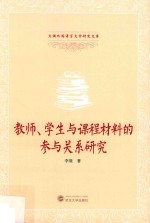

教师、学生与课程材料的参与关系研究PDF电子书下载
- 电子书积分:10 积分如何计算积分?
- 作 者:李展著
- 出 版 社:武汉:武汉大学出版社
- 出版年份:2018
- ISBN:9787307206441
- 页数:208 页
Chapter One Introduction 1
1.1 Motivation for the Study 1
1.2 Background of the Study 4
1.3 Aims of the Study and Research Questions 6
1.4 Structure of the Book 8
Chapter Two Teachers’Enactment of Curriculum Materials:A Participatory Perspective 9
2.1 Defining Key Concepts in the Study 9
2.1.1 Curriculum Materials vs.Materials 9
2.1.2 Curriculum Materials Use vs.Materials Development 11
2.2 The Role of English Language Textbooks in the Global Context 12
2.3 CE Curriculum and Textbooks in Mainland China 14
2.3.1 The Evolution of CE Curriculum 14
2.3.2 Five Generations of CE Textbooks 17
2.4 Research on the Teacher-Curriculum Relationship in ELT 20
2.4.1 Teachers’Adaptation of Materials 20
2.4.2 Teachers’Use of Materials in ELT 21
2.5 Research on the Teacher-Curriculum Relationship in Mainstream Education 24
2.5.1 The Educative Role of Curriculum Materials and Teacher Learning 27
2.5.2 Teachers’Factors Influencing Their Use of Curriculum Materials 29
2.6 The Theoretical Framework of the Study 29
2.6.1 Theoretical Perspectives on Curriculum Use 29
2.6.2 The Theoretical Perspective of This Study 30
2.6.3 The Theoretical Framework of This Study 32
2.7 Summary 34
Chapter Three Methodology 35
3.1 Qualitative Multi-Case Study 35
3.2 Selection of Setting,Participants and Materials 37
3.2.1 The Target University 38
3.2.2 Participants 39
3.2.3 Target Textbook 41
3.3 Data Collection 45
3.3.1 Data Collection Schedule 46
3.3.2 Data Collection Strategies 48
3.4 Data Analysis 55
3.4.1 Analysis of Interview Data 56
3.4.2 Analysis of Observational Data 57
3.4.3 Documentary Analysis 59
3.5 Trustworthiness 59
3.5.1 Triangulation 60
3.5.2 Thick Description 60
3.5.3 Member Checking 61
3.5.4 Management of Subjectivity 61
3.5.5 Ethical Considerations in Data Collection 62
3.6 Summary 63
Chapter Four Teachers’Use of and Interactions with the Curriculum Materials 64
4.1 Scope of the Chapter 64
4.2 Features of Teachers’Interactions with the Curriculum Materials 64
4.3 Map of Teachers’Interactions with the Curriculum Materials 66
4.4 Reading 67
4.4.1 Reading the Students’Book 67
4.4.2 Reading the Teachers’Book 74
4.5 Evaluating 82
4.6 Appropriating and Adapting 85
4.6.1 Adjusting 85
4.6.2 Replacing 87
4.6.3 Supplementing 89
4.6.4 Omitting 91
4.6.5 Revising 92
4.6.6 Inventing 93
4.7 Understanding Teachers’Actions 96
4.7.1 The Meaning of the Teachers’Reading Process 96
4.7.2 The Meaning of the Teachers’Evaluation Process 99
4.7.3 The Meaning of Teachers’Appropriating and Adapting Processes 100
4.8 Summary 103
Chapter Five Influences on Teachers’Interactions with the Curriculum Materials 105
5.1 Overview of the Influential Factors of Teacher-Text Interactions 105
5.2 Contextual Factors Affecting Teacher-Text Interactions 106
5.2.1 Aspects of the Local Cultures 106
5.2.2 Support for Teachers with Regard to Curriculum Material Use 108
5.2.3 Inflexibility of the CE Curriculum 112
5.3 Features of the Curriculum Materials 114
5.4 Teachers’Personal Resources 120
5.4.1 Teachers’Beliefs 120
5.4.2 Teachers’Management of Curriculum Materials 123
5.4.3 Teachers’Knowledge 124
5.4.4 Teachers’Curricular and Pedagogical Goals 128
5.5 Student Voice 130
5.6 Summary 136
Chapter Six Discussion 137
6.1 Findings of the Current Study 138
6.1.1 Responding to the First Research Question 138
6.1.2 Responding to the Second Research Question 139
6.2 Conceptualising the Enactment of Curriculum Materials 141
6.2.1 Theoretical Underpinnings of the Study 142
6.2.2 Theorising Curriculum Materials:Multi-Layered Affordances of Curriculum Materials 143
6.2.3 Formation of the Curriculum Instruments:From Artefacts to Instruments 146
6.2.4 Mediated Relations in Enacting Curriculum Materials 149
6.2.5 Teachers’Knowledge in Materials Use 154
6.3 Instrumentation:Curriculum Materials Shaping Curriculum Enactment 155
6.3.1 The Ostensible Authority of Curriculum Materials in ELT in the Chinese Context 156
6.3.2 The Educative Role of Curriculum Materials 158
6.4 Instrumentalisation:Teachers’Role in Shaping the Curriculum Materials 160
6.4.1 Conceptualising Teachers’Use of Curriculum Materials:Teachers’Cognitive Processes 160
6.4.2 Adaptation of Curriculum Materials 162
6.5 The Participatory Relations Among Teachers,Learners,Curriculum Materials and the Context 164
6.5.1 Teacher Voice 167
6.5.2 Student Voice 168
6.6 Revisiting the Theoretical Framework 169
6.7 Summary 172
Chapter Seven Conclusions and Implications 174
7.1 Summary of the Study 174
7.1.1 The Purpose and Methodology of the Study 174
7.1.2 Summary of the Findings 176
7.2 Significance of the Study 178
7.3 Implications 180
7.3.1 Theoretical Implications 180
7.3.2 Practical Implications 182
7.4 Limitations and Recommendations for Future Research 188
Appendix Ⅰ Baseline Teacher Interview Protocol 190
Appendix Ⅱ Pre- and Post-Observation Teacher Interviews 193
Appendix Ⅲ Baseline Student Interview Protocol 194
Appendix Ⅳ Observation Analysis 195
References 196
- 《SQL与关系数据库理论》(美)戴特(C.J.Date) 2019
- 《培智学校义务教育实验教科书教师教学用书 生活适应 二年级 上》人民教育出版社,课程教材研究所,特殊教育课程教材研究中心编著 2019
- 《中央财政支持提升专业服务产业发展能力项目水利工程专业课程建设成果 设施农业工程技术》赵英编 2018
- 《超级参与者》王金强责编;赵磊译者;(澳)杰里米·海曼斯,(英)亨利·蒂姆斯 2020
- 《全国学前教育专业(新课程标准)“十三五”规划教材 简谱手风琴教程 第2版》(中国)杨克勤,王宝庆 2019
- 《教师新观念》王丽琴主编;吕萍,朱爱忠,严红等编委 2019
- 《材料导论》张会主编 2019
- 《高等教育双机械基础课程系列教材 高等学校教材 机械设计课程设计手册 第5版》吴宗泽,罗圣国,高志,李威 2018
- 《环境影响评价公众参与理论与实践研究》樊春燕主编 2019
- 《公共关系》胡杏菁,罗永全,连伟文主编 2018
- 《蔡文展现代乐理系统教程》蔡文展著 2019
- 《滋补养颜甜品 第2版》李曾鹏展著 1996
- 《湖北文学专题论稿》李展著 2015
- 《文秘写作教程》李佩英,叶坤妮主编;赵永生,李展,孙若飞副主编 2010
- 《中国现代主义文学史论 中》李林展著 2010
- 《千帆诗学与中国哲学》周欣展著 2013
- 《马援》陈子展著 1933
- 《品德成长》贾真,潘健主编;施晓卫,都樾副主编;李展,吴菊云,汪薛松等参编 2010
- 《中国现代主义文学史论 上》李林展著 2010
- 《新闻写作》吴良勤,李展编著 2010
- 《大学计算机实验指导及习题解答》曹成志,宋长龙 2019
- 《大学生心理健康与人生发展》王琳责任编辑;(中国)肖宇 2019
- 《大学英语四级考试全真试题 标准模拟 四级》汪开虎主编 2012
- 《大学英语教学的跨文化交际视角研究与创新发展》许丽云,刘枫,尚利明著 2020
- 《复旦大学新闻学院教授学术丛书 新闻实务随想录》刘海贵 2019
- 《大学英语综合教程 1》王佃春,骆敏主编 2015
- 《大学物理简明教程 下 第2版》施卫主编 2020
- 《大学化学实验》李爱勤,侯学会主编 2016
- 《中国十大出版家》王震,贺越明著 1991
- 《近代民营出版机构的英语函授教育 以“商务、中华、开明”函授学校为个案 1915年-1946年版》丁伟 2017
